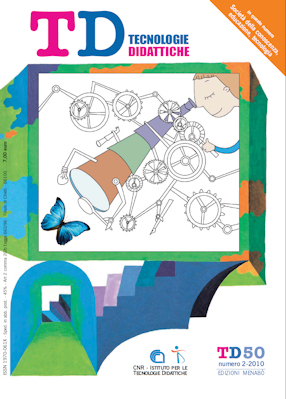Learning, technology, and school in the learning society
Main Article Content
Abstract
Article Details
Authors who publish with this journal agree to the following terms:
- Authors retain copyright and grant the journal right of first publication with the work simultaneously licensed under a Creative Commons CC BY 4.0 Attribution 4.0 International License.
- Authors are able to enter into separate, additional contractual arrangements for the non-exclusive distribution of the journal's published version of the work (e.g., post it to an institutional repository or publish it in a book), with an acknowledgement of its initial publication in this journal.
- Authors are permitted and encouraged to post their work online (e.g., in institutional repositories or on their website) prior to and during the submission process, as it can lead to productive exchanges, as well as earlier and greater citation of published work (See The Effect of Open Access)
References
Austin N. (2003). Mighty white. The Guardian. URL:http://www.guardian.co.uk/education/2003/jan/07/elearning.technology6 (ultima consultazione 20 aprile 2010).
Authier M., Lévy P. (2000). Gli alberi della conoscenza. Educazione e gestione dinamica delle competenze. Milano: Feltrinelli.
Bauman Z. (1999). Dentro la globalizzazione. Le conseguenze sulle persone. Roma; Bari: Editori Laterza.
Bereiter C., Scardamalia M. (1994). Computer support for knowledge-building communities. Journal of the Learning Sciences, 3(3), pp. 265-283.
Boyle J. (2002). Virtual magic. Times Educational Supplement, 26 Aprile 2002.
Bransford J. D., Sherwood R. D., Hasselbring T. S., Kinzer C. K., Williams S. M. (1990). Anchored instruction: Why we need it and how technology can help. In D. Nix e R. Spiro (eds.). Cognition, education and multimedia: Exploring ideas in high technology. Hillsdale: Lawrence Erlbaum Associates, pp. 115-141.
Cacciamani S. (2008). Imparare Cooperando. Carocci: Roma.
Carson L. (2003). Board work, not boring. Times Educational Supplement, 9 maggio 2003.
Delors J. (1997). Nell’educazione un tesoro. Roma: Armando Editore.
de Kerckhove D. (1993). Brainframes. Mente, tecnologia, mercato. Bologna: Baskerville.
Desiderio A. C. (2009). Metodologie didattiche ed esperienze di apprendimento. In F. Faiella (a cura di). Progettare la didattica costruttivista. Lecce: Pensa Editore, pp. 39-53.
Eco U. (2003). Apocalittici e integrati. Milano: Bompiani.
Galli C. (2006). Multiculturalismo. Idealismo e sfide. Bologna: Il Mulino.
Glover D., Miller, D. (2001). Running with technology: the pedagogic impact of the large scale introduction of interactive whiteboards in one secondary school. Journal of Information Technology for Teacher Education, 10, pp. 257-276.
Greiffenhagen C. (2000) A Report into Whiteboard Technologies. Oxford: Computing Laboratory.
Guimarães N., Chambel T., Bidarra J. (2000). From Cognitive Maps to Hypervideo: supporting flexible and rich learner-centred environment. Interactive Multimedia Electronic Journal of Computer Enhanced Learning, 2(2).
Hennessy S., Deaney R., Ruthven K., Winterbottom M. (2007). Pedagogical strategies for using the interactive whiteboard to foster learner participation in school science. Learning, Media and Technology, 32(3), pp. 283-301.
Jonassen D. H. (1992). Evaluating Constructivist Learning. In T. M. Duffy, D. H. Jonassen (eds.) Constructivism and the technology of instruction: a conversation. Hillsdale: Lawrence Erlbaum Associates, pp. 137-148.
Jonassen D. H. (1994). Technology as Cognitive Tools: Learners as Designers. ITForum. URL: http://itech1.coe.uga.edu/itforum/paper1/paper1.html (ultima consultazione 20 aprile 2010).
Jonassen D. H., Land S. M. (2000). Theoretical Foundations of Learning Environments. London: Lawrence Erlbaum Associates.
Jonassen D.H., Howland J., Marra R.M., Crismond D. (2008). Meaningful learning with technology. Columbus, OH: Merrill/Prentice Hall.
Kurzweil R. (1992). The future of libraries. Part 2: the end of books. Library Journal, February 15, pp.140-42. URL: http://www.kurzweilai.net/articles/art0261.html?printable=1 (ultima consultazione 20 aprile 2010).
Lévy P. (1999). Cybercultura. Gli usi sociali delle nuove tecnologie. Milano: Feltrinelli.
Ligorio M. B. (2006). Tecnologie ed innovazione curricolare. In F. Faiella (a cura di). I percorsi ed i processi della didattica multimediale. Lecce: Pensa Editore, pp. 65-72.
McLuhan M. (1967). Gli strumenti del comunicare. Milano: Il Saggiatore.
Merrill M. D. (1991). Constructivism and Instructional Design. Educational Technology, 31(5), pp. 45-53.
Morin E. (1993). Introduzione al pensiero complesso. Milano: Sperling & Kupfer.
Olson J. (2000). Trojan horse or teacher’s pet? Computers and the culture of the school. Journal of Curriculum Studies, 32(1), pp. 1-8.
Prensky M. (2001). Digital Natives, Digital Immigrants. On the Horizon, 9(5). URL: http://www.marcprensky.com/writing/Prensky%20-%20Digital%20Natives,%20Digital%20Immigrants%20-%20Part1.pdf (ultima consultazione 20 aprile 2010).
Papert S. (1994). I bambini e il computer. Milano: Rizzoli.
Resnick, L. B. (1995). Imparare dentro e fuori la scuola. In C. Pontecorvo, A. M. Ajello, C. Zucchermaglio (a cura di). I contesti sociali dell’apprendimento. Milano: LED, pp. 61-84.
Robertson R. R. (1995). Glocalization: Time-Space and HomogeneityHeterogeneity. In M. Featherstone, S. Lash, R. R. Robertson (eds.). Global Modernities. London: Sage, pp. 25-44.
Roncaglia G. (2010). La quarta rivoluzione. Sei lezioni sul futuro del libro. Roma-Bari: Laterza.
Rotta M., Bini M., Zamperlin P. (2010). Insegnare e apprendere con gli ebook. Roma: Garamond.
Scardamalia M., Bereiter C. (1999). Schools as knowledge building organizations. In D. Keating, C. Hertzman (eds). Today’s children, tomorrow’s society: The developmental health and wealth of nations. New York: Guilford, pp. 274-289.
Scardamalia M., Bereiter C. (2006). Knowledge building: Theory, pedagogy, and technology. In K. Sawyer (ed.). Cambridge Handbook of the Learning Sciences. New York: Cambridge University Press, pp. 97-118.
Schön D. A. (1973). Beyond the Stable State. Public and private learning in a changing society. Harmondsworth: Penguin. Smith H. J., Higgins S., Wall K., Miller J. (2005). Interactive whiteboards: Boon or bandwagon? A critical review of the literature. Journal of Computer Assisted Learning, 21, pp. 91-101.
Toffler A. (1976). Il pensiero avanzato. In K. W. Richmond (a cura di). Educazione permanente nella società aperta. Roma: Armando Armando, pp. 56-63.
Thompson J. B. (2005). Books in the digital age. Cambridge: Polity Press.
Vertecchi B. (1999). L’illetteratismo: un’insidia per la democrazia. In Annali della Pubblica Istruzione. L’educazione permanente degli adulti. Firenze: Le Monnier, pp. 5-18.
Wenger E. (2006). Comunità di pratica. Apprendimento, significato e identità. Milano: Raffaello Cortina Editore.
FURTHER READING
Biondi G. (2008). LIM. A scuola con la lavagna interattiva multimediale. Nuovi linguaggi per innovare la didattica. Firenze: Giunti.
Bonaiuti G. (2009). Didattica attiva con la LIM. Trento: Erickson.
Carrière J. C., Eco U. (2009). Non sperate di liberarvi dei libri. Milano

